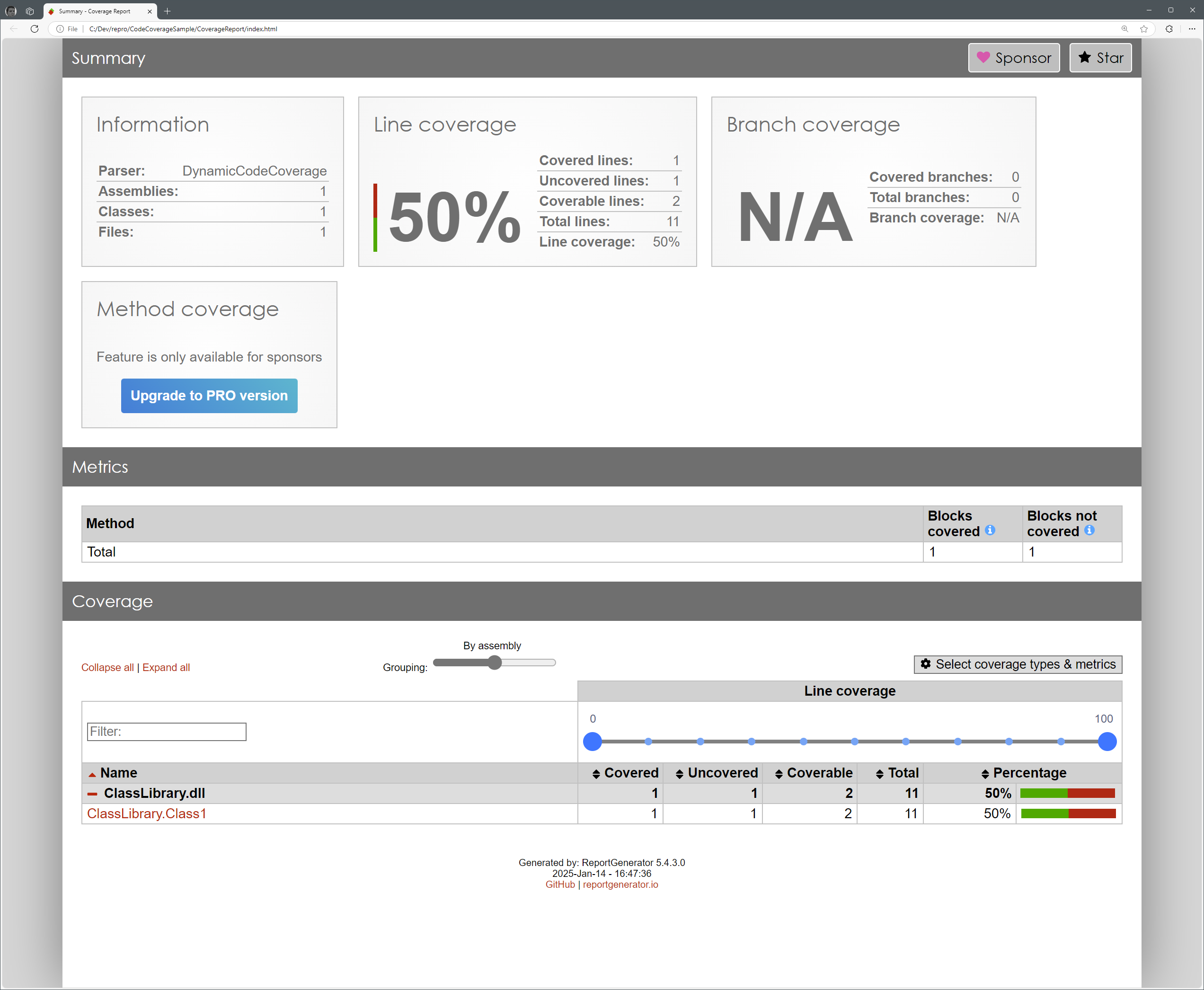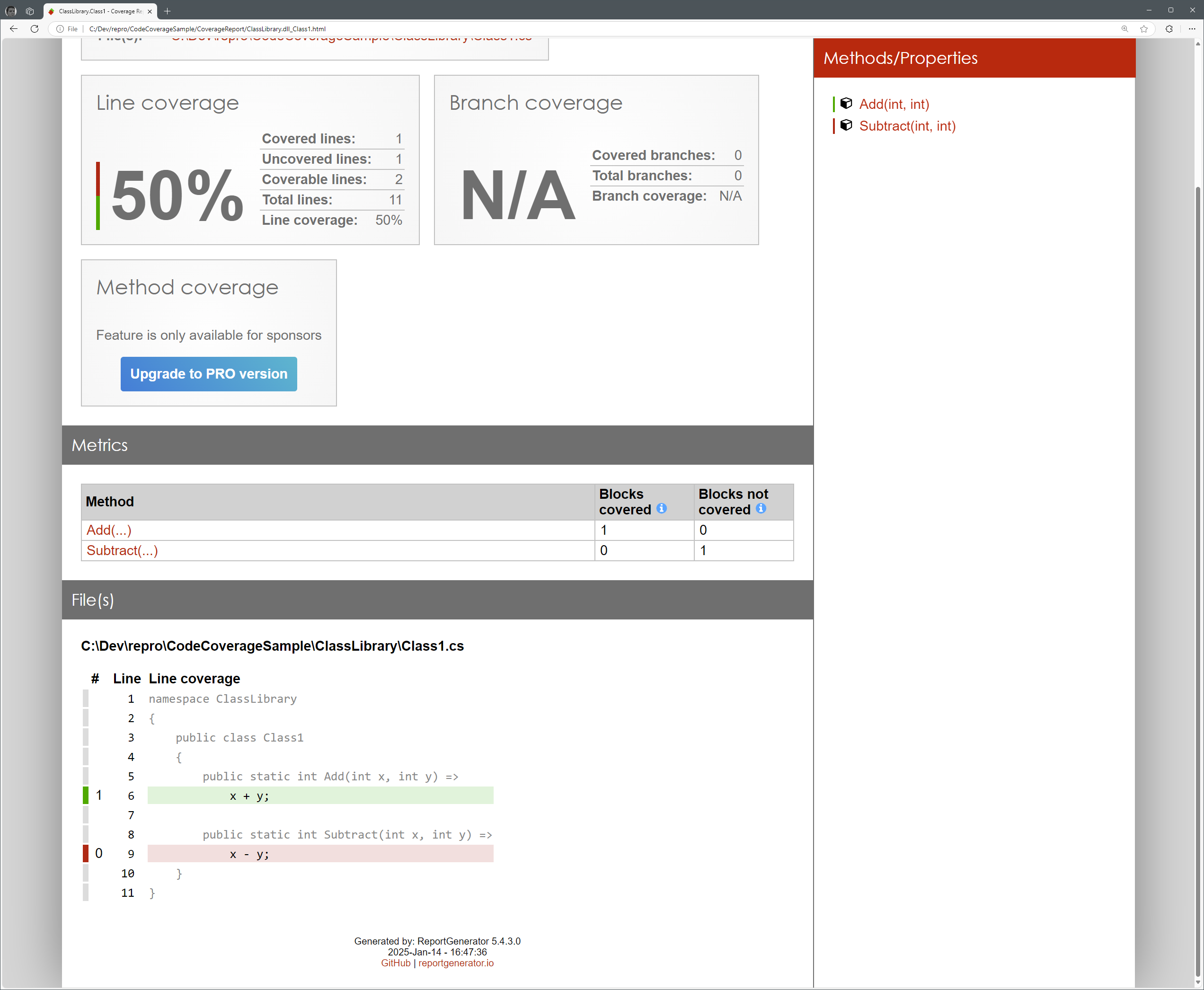Code Coverage with MTP 2025 May 2
With the new Microsoft Testing Platform support (MTP) in xUnit.net v3, getting code coverage has changed when running with MTP. This document discusses how to enable code coverage for both the MTP native command line via dotnet run as well as when using dotnet test.
Note
The samples here are done with xUnit.net v3 2.0.1 and .NET SDK 9.0.203. Your output text or version numbers may look slightly different from the examples given here.
Setting up a sample project
We're going to walk through a simple sample project so we can see code coverage in action with MTP. These quick instructions will assume you're comfortable using the command line .NET SDK tooling.
If you want to skip these steps and just download the sample project, it's available as a ZIP file.
If you have not already installed the v3 templates, please do so now:
$ dotnet new install xunit.v3.templates The following template packages will be installed: xunit.v3.templates Success: xunit.v3.templates::2.0.1 installed the following templates: Template Name Short Name Language Tags ------------------------------ ---------------- ---------- ---------- xUnit.net v3 Extension Project xunit3-extension [C#],F#,VB Test/xUnit xUnit.net v3 Test Project xunit3 [C#],F#,VB Test/xUnitCreate a folder for our sample project, and create our solution file:
$ mkdir CodeCoverageSample $ cd CodeCoverageSample $ dotnet new sln The template "Solution File" was created successfully.Create a class library and add it to the solution:
$ dotnet new classlib -f net8.0 -o ClassLibrary The template "Class Library" was created successfully. Processing post-creation actions... Restoring ClassLibrary\ClassLibrary.csproj: Restore succeeded. $ dotnet sln add ClassLibrary Project `ClassLibrary\ClassLibrary.csproj` added to the solution.Replace the contents of
ClassLibrary\Class1.cswith the following:namespace ClassLibrary; public class Class1 { public static int Add(int x, int y) => x + y; public static int Subtract(int x, int y) => x - y; }This will give us code for us to measure coverage against.
Create the unit test project, add it to the solution, and add a reference to the class library:
$ dotnet new xunit3 -o Tests The template "xUnit.net v3 Test Project" was created successfully. Processing post-creation actions... Restoring Tests\Tests.csproj: Restore succeeded. $ dotnet sln add Tests Project `Tests\Tests.csproj` added to the solution. $ dotnet add Tests reference ClassLibrary Reference `..\ClassLibrary\ClassLibrary.csproj` added to the project.Replace the contents of
Tests\UnitTest1.cswith the following:using ClassLibrary; public class UnitTest1 { [Fact] public void AddTest() { Assert.Equal(5, Class1.Add(2, 3)); } }Finally, edit
Tests\Tests.csprojand add the following items to the top<PropertyGroup>:<TestingPlatformDotnetTestSupport>true</TestingPlatformDotnetTestSupport> <UseMicrosoftTestingPlatformRunner>true</UseMicrosoftTestingPlatformRunner>With all of this done, let's ensure that our tests are able to run, and that we're in MTP mode:
$ dotnet run --project Tests xUnit.net v3 Microsoft.Testing.Platform Runner v2.0.1+b2368b05c7 (64-bit .NET 8.0.12) Test run summary: Passed! - Tests\bin\Debug\net8.0\Tests.dll (net8.0|x64) total: 1 failed: 0 succeeded: 1 skipped: 0 duration: 163ms
Enabling code coverage
With xUnit.net v3 and MTP, there is a solution for code coverage that's supported directly by Microsoft.
One of the big new features for MTP is for the ability of developers to write "extensions" that can extend the functionality of unit testing frameworks by mixing in functionality via custom command line options. The documentation page for MTP extensions is a good place to start when looking for these extensions.
Today we're focusing on the Microsoft Code Coverage extension. To use this extension, we must add a package reference like this:
$ dotnet add Tests package Microsoft.Testing.Extensions.CodeCoverage
Build succeeded in 0.4s
info : X.509 certificate chain validation will use the default trust store selected by .NET for code signing.
info : X.509 certificate chain validation will use the default trust store selected by .NET for timestamping.
info : Adding PackageReference for package 'Microsoft.Testing.Extensions.CodeCoverage' into project 'Tests\Tests.csproj'.
info : GET https://api.nuget.org/v3/registration5-gz-semver2/microsoft.testing.extensions.codecoverage/index.json
info : OK https://api.nuget.org/v3/registration5-gz-semver2/microsoft.testing.extensions.codecoverage/index.json 145ms
info : Restoring packages for Tests\Tests.csproj...
info : CACHE https://api.nuget.org/v3/vulnerabilities/index.json
info : CACHE https://api.nuget.org/v3-vulnerabilities/2025.04.17.23.39.46/vulnerability.base.json
info : CACHE https://api.nuget.org/v3-vulnerabilities/2025.04.17.23.39.46/2025.05.02.11.40.56/vulnerability.update.json
info : Package 'Microsoft.Testing.Extensions.CodeCoverage' is compatible with all the specified frameworks in project 'Tests\Tests.csproj'.
info : PackageReference for package 'Microsoft.Testing.Extensions.CodeCoverage' version '17.14.2' added to file 'Tests\Tests.csproj'.
info : Generating MSBuild file Tests\obj\Tests.csproj.nuget.g.props.
info : Generating MSBuild file Tests\obj\Tests.csproj.nuget.g.targets.
info : Writing assets file to disk. Path: Tests\obj\project.assets.json
log : Restored Tests\Tests.csproj (in 106 ms).
Once this reference has been added, we can see that four new command line switches have become available to us:
$ dotnet run --project Tests -- -?
[...]
--coverage
Collect the code coverage using dotnet-coverage tool
--coverage-output
Output file
--coverage-output-format
Output file format. Supported values: 'coverage', 'xml' and 'cobertura'
--coverage-settings
XML code coverage settings
[...]
Passing --coverage is the minimum requirement for enabling code coverage; the other three switches influence how the coverage information is reported.
Generating code coverage XML
Using dotnet run
Let's run our test project with coverage enabled, and ensure that it's generating XML formatted results for our report generator.
$ dotnet run --project Tests -- --coverage --coverage-output-format cobertura --coverage-output coverage.cobertura.xml
xUnit.net v3 Microsoft.Testing.Platform Runner v2.0.1+b2368b05c7 (64-bit .NET 8.0.12)
In process file artifacts produced:
- Tests\bin\Debug\net8.0\TestResults\coverage.cobertura.xml
Test run summary: Passed! - Tests\bin\Debug\net8.0\Tests.dll (net8.0|x64)
total: 1
failed: 0
succeeded: 1
skipped: 0
duration: 234ms
The output now shows the XML file that's been generated with code coverage information. If we peek at the first few lines of the XML file we should see coverage information like this:
[...]
<class line-rate="0.5" branch-rate="1" complexity="2" name="ClassLibrary.Class1" filename="ClassLibrary\Class1.cs">
<methods>
<method line-rate="1" branch-rate="1" complexity="1" name="Add" signature="(int, int)">
<lines>
<line number="6" hits="1" branch="False" />
</lines>
</method>
<method line-rate="0" branch-rate="1" complexity="1" name="Subtract" signature="(int, int)">
<lines>
<line number="9" hits="0" branch="False" />
</lines>
</method>
</methods>
<lines>
<line number="6" hits="1" branch="False" />
<line number="9" hits="0" branch="False" />
</lines>
</class>
[...]
Using dotnet test
Generating coverage XML is very similar to using dotnet run, except that we pass the extra arguments to dotnet test instead:
$ dotnet test -- --coverage --coverage-output-format cobertura --coverage-output coverage.cobertura.xml
Restore complete (0.2s)
ClassLibrary succeeded (0.1s) → ClassLibrary\bin\Debug\net8.0\ClassLibrary.dll
Tests succeeded (0.4s) → Tests\bin\Debug\net8.0\Tests.dll
Tests test succeeded (0.8s)
Test summary: total: 1, failed: 0, succeeded: 1, skipped: 0, duration: 0.7s
Build succeeded in 1.9s
Note that we don't see the name of the coverage output file, which is why we use --coverage-output coverage.cobertura.xml so that the report always has a known filename.
If you run dotnet test and it runs multiple test projects, each test project's TestResults folder will have a coverage.cobertura.xml file with the coverage results from that particular test run.
Using ReportGenerator to create HTML from the XML
The XML isn't particularly pretty to look at, so for human consumption we'd like to see HTML reports.
We'll use a tool called ReportGenerator to convert the XML coverage into HTML reports. If you don't already have this installed, you can run this command:
$ dotnet tool install --global dotnet-reportgenerator-globaltool
You can invoke the tool using the following command: reportgenerator
Tool 'dotnet-reportgenerator-globaltool' (version '5.4.3') was successfully installed.
Now we just need to generate the HTML report:
$ ReportGenerator -reports:Tests\bin\Debug\net8.0\TestResults\coverage.cobertura.xml -targetdir:CoverageReport
2025-05-02T17:09:06: Arguments
2025-05-02T17:09:06: -reports:Tests\bin\Debug\net8.0\TestResults\coverage.cobertura.xml
2025-05-02T17:09:06: -targetdir:CoverageReport
2025-05-02T17:09:06: Writing report file 'CoverageReport\index.html'
2025-05-02T17:09:06: Report generation took 0.1 seconds
If you open the index.html file in your browser you should see a report that looks something like this:
You can click on the ClassLibrary.Class1 to dive into the coverage details:
Code coverage is showing us that our test have only covered the Add method, and not the Subtract method, which is correct given that our unit test sample only included a single test for Add.
At this point, you should be able to write a second test for Subtract, re-run the tests (with coverage), re-generate the report, and see the updated code coverage results.

